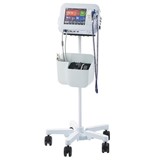Dr Josephine Barbaro has developed an accurate set of "red flag" markers of the condition, which include a failure by babies to make consistent eye contact, to smile, show their toys to others, to play social games, point and respond when their name is called.
Dr Barbaro, who works out of La Trobe's Olga Tennison Autism Research Centre, is training medical experts around the globe in the use of her diagnostic method on children under two years of age and has just returned from working with Chinese health authorities.
She said it was really exciting that the early diagnosis criteria was making a difference.
"All typically developing babies are pre-wired to be social, look at other people's faces, learn from them and copy what they're doing; children with autism are not doing this — and we can now accurately identify this at a much younger age and take action," Dr Barbaro said.
Her work is helping educate maternal and child health nurses to use these criteria during regular health checks of all babies. Early detection is the key to intervention and often a better long-term outcome for children.
Dr Barbaro and her team are training doctors in Melbourne's sister city Tianjin in China, as part of an Australia-China Science and Research Fund Group Mission. They have helped to train 300 doctors monitor children's development using the early autism identification program.
So far 10,000 babies aged from 12 to 24 months have been checked. The majority of babies referred for follow via her test have been diagnosed as on the spectrum.
Based on these preliminary findings, the Tianjin government has agreed to conduct autism surveillance using Dr Barbaro's program for every child born in the city for the next seven years.
The team is also training healthcare workers in Poland, Korea, Japan and Bangladesh. It is continuing to work with maternal health nurses and clinicians to roll out the development surveillance training across Australia in the coming year.
An estimated 1 in 100 children have an autism spectrum disorder. The lifelong developmental disability is characterised by difficulties with social interaction, verbal and no-verbal communication, restricted interests and repetitive behaviour.



